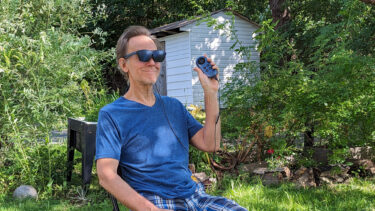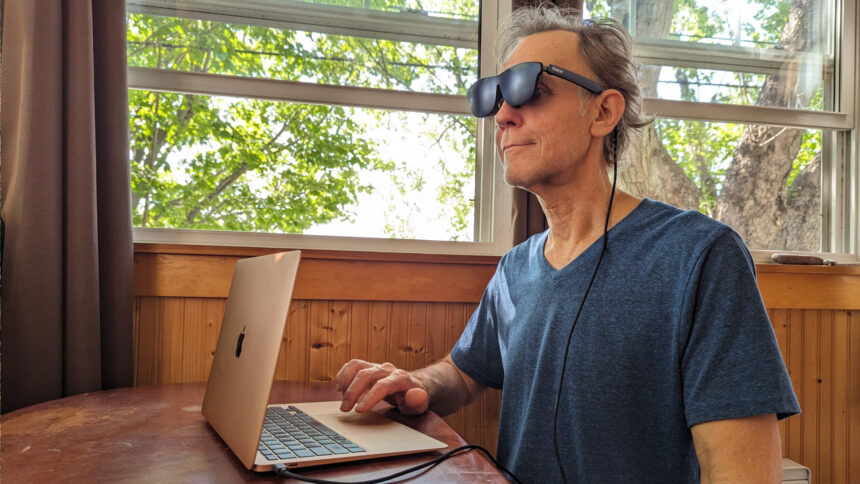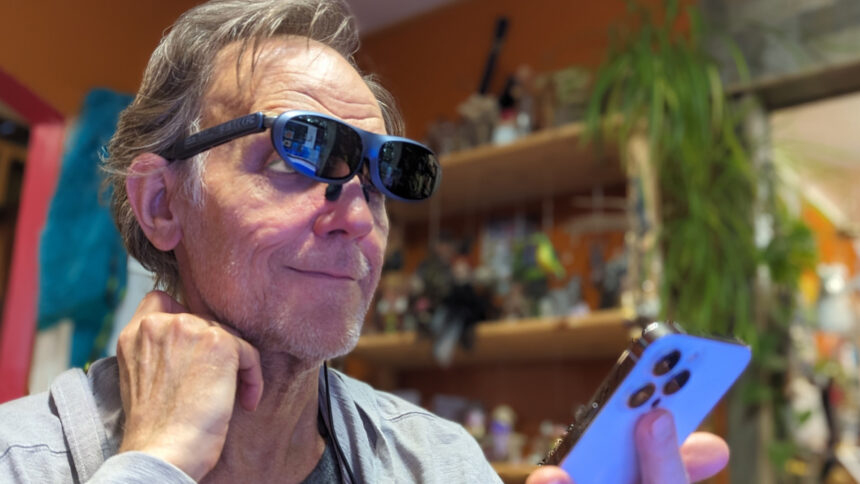Hands-on with Rokid Max and Rokid Station

Rokid Max smart glasses pair nicely with the new Rokid Station, which adds Android TV features and eliminates compatibility issues.
I got an opportunity to try the new Rokid Max and Rokid Station bundle, and I'm quite pleased with the image sharpness, color saturation, and brightness of the display in the glasses.
Adding the Rokid Station accessory makes this a standalone system since it runs Android TV and includes a 5-hour battery. It also supports casting from most devices.
Rokid Max and the 215-inch TV
Rokid claims its Max glasses can display a screen equivalent in size to a 215-inch TV. That's true, but perceived size varies with my environment. When I look at a far wall, the display appears larger. When I look at a close wall, it seems smaller.
The field of view (FOV) and pixels per degree (PPD) are the details that really matter when comparing virtual displays. Rokid Max has an FOV of 50 degrees, among the widest for smart glasses. Rokid hasn't shared its PPD, but it looks remarkably sharp, roughly on par with Xreal Air.
Rokid Max has a refresh rate of up to 120Hz, although most video content is at 60Hz. When you attach to a device that supports 120Hz for gaming, more frequent screen updates can make a difference.

When the Rokid Max is connected directly to my MacBook, I can keep my head up. | Image: Mixed
The display brightness is also notable, reaching 600 nits. That's not good enough for viewing in sunlight, but it works great in most indoor lighting. There's an easy solution for using Rokid Max in the sunlight. Rokid includes a snap-on shade that blocks light from the front without interfering with peripheral vision.
The display in the Rokid Max compares favorably to Xreal Air. Both provide wide FOVs and high enough pixel density to make text crisp on a large virtual screen. I use the Rokid Max to watch videos and as a replacement for my MacBook's display, and it works beautifully in both cases.
Rokid Max + Rokid Station
Compatibility is a problematic issue for most smart glasses, including Rokid Max. A technology called DisplayPort over USB-C or USB-C Alt mode is required. That makes it challenging to connect a large virtual screen to iPhones. The same problem affects many Android phones.
That's where the Rokid Station can help. Rather than connect various adapters and cables in an awkward mess, I can cast a video from my iPhone or Pixel phone to the Rokid Station.
Rokid Station works with many video streaming apps, including YouTube, Netflix, Disney+, Prime Video, and other Chromecast-enabled apps. I can cast from a Chrome browser also.

Via the Rokid Station, my iPhone can cast to Rokid Max glasses. | Image: Mixed
If I play a video directly from the Rokid Station, I don't need to cast at all. This pocket-sized device runs Android TV, a version of the Android operating system that Google optimized for televisions.
Several Google apps are pre-installed, including YouTube, YouTube Music, Google Play Movies & TV, Google Play Store, and Google Play Games. A substantial number of video and music streaming apps are available in the Play Store, as well as many entertaining games.
I installed Prime Video, Amazon Music, Spotify, Hoopla, and Tubi. I highly recommend Beach Buggy Racing as a great way to test your reflexes while having fun with Rokid Max glasses and Rokid Station.
Xreal took a similar but different approach for its smart glasses. The Xreal Air + Beam bundle provides Wi-Fi connectivity but requires a phone or other source for video.
Rokid Station includes several buttons for navigation. An included TV remote provides an alternate way to select content with less bulk and weight. I also paired a Bluetooth keyboard and could type in the Play Store and a few other apps.
Android TV is versatile but limited. In particular, I couldn't find any of the chat or productivity apps I use on my Android phone. Google Meet was already installed, so I tested it. I accepted a video call and could see the person calling while they could only hear my voice.
Bundle savings
Rokid Max retails at $599, but it's currently available for $439. Rokid Station is $129. Bundle pricing provides a $70 savings, so you can pick up both for $529. An upcoming back-to-school sale from August 25 to September 8, 2023, lowers the bundle price to $489.

The Rokid Max plus Station bundle includes sun shades, a cable, and remote control. | Image: Mixed
That's the price of a smart TV that I can watch along with others, while the Rokid Max + Station bundle is a personal theater and gaming system. The TV might be a better choice for sharing, but I can't carry a 65-inch TV around when I travel.
The Rokid Max + Station bundle doesn't provide tracking features like AR glasses, but it does accept voice input. I also get a giant, crisp and vibrant virtual screen.
The glasses weigh about as much as two pairs of sunglasses. After a couple of hours, I felt some pressure on my nose. Each person has a different tolerance for weight on the face. If you've used a VR headset, even something as light as the Bigscreen Beyond, smart glasses feel like nothing by comparison.
Beyond the weight, this bundle should be enjoyable for anyone if it's within the budget. I like the Rokid Max glasses and enjoy the ease of use with the Rokid Station.
Note: Links to online stores in articles can be so-called affiliate links. If you buy through this link, MIXED receives a commission from the provider. For you the price does not change.